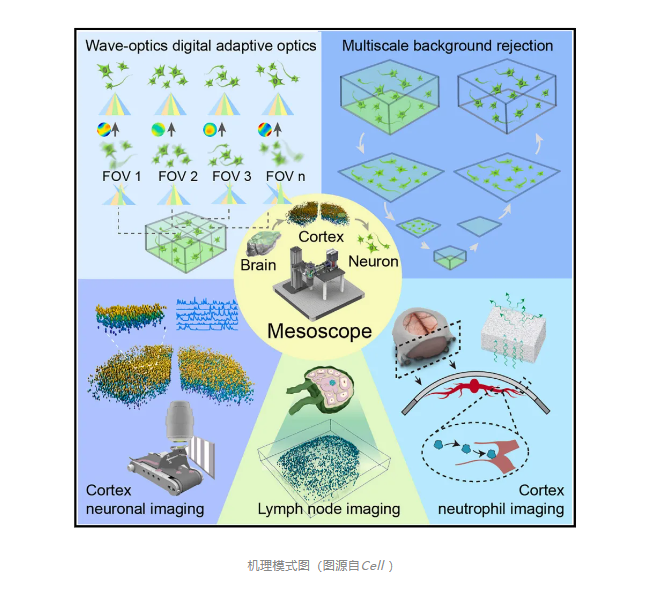14
2024
-
09
Subversion of the past! Tsinghua University Dai Qionghai/Guo Zengcai/Wu Jiamin Cooperation Latest Cell
Author:
A comprehensive understanding of physiopathological processes requires non-invasive live three-dimensional (3D) imaging on different spatial and temporal scales.However, huge data throughput, optical non-uniformity, surface irregularities, and phototoxicity pose huge challenges, resulting in inevitable trade-offs between volume size, resolution, speed, sample health, and system complexity.
On September 13, 2024, Tsinghua University Dai Qionghai, Guo Zengcai and Wu Jiamin jointly communicated inCellOnline is titled“Long-term mesoscale imaging of 3D intercellular dynamics across a mammalian organ”The research paper,The studyIntroduced a compact real-time, ultra-large-scale, high-resolution 3D colonoscopy (RUSH3D), under the low phototoxicity of 20Hz, at 8,000 × 6,000×400 μm3The volume of the achieved 2.6×2.6×6 μm3of uniform resolution.
By integrating multiple computational imaging technologies, RUSH3D improves data throughput by a factor of 13 and reduces system size and cost by several orders of magnitude. Using these advantages, the researchers observed pre-motor neural activity and cross-day visual representation drift in the mouse cortex, the formation and progression of multiple germinal centers in the mouse inguinal lymph nodes, and a heterogeneous immune response after traumatic brain injury-All of this was performed at single-cell resolution, opening up horizons for in vivo mesoscale studies of large-scale cell-cell interactions at the organ level.

Chongqing Chongfan Technology Co., Ltd. Optical platform film thickness meter OCT optical coherence tomography LabVIEW control
LATEST NEWS
2024-09-16
Tsinghua University Xiao Bailong/Peking University Ouyang Kunfu Collaboration Reveals Key Phosphorylation Sites That Regulate Piezo1 Mechanical Sensitivity and Mechanotransduction Function in Vivo
Piezo1 is a mechanically activated cation channel that can convert mechanical forces into various physiological processes. Due to its large protein size of more than 2500 amino acids and complex 38 transmembrane helix topology, how Piezo1 is post-translationally modified to regulate its mechanotransduction function in vivo remains unexplored.
2024-09-18
Huazhong University of Science and Technology Wang Cong Yi/Sun Fei found in obese environment really pathogenic adipose tissue macrophage subsets
Adipose tissue macrophages (ATMs) play an important role in maintaining adipose tissue homeostasis and coordinating metabolic inflammation. Given the extensive functional heterogeneity and phenotypic plasticity of ATMs, there is a need to identify truly pathogenic subpopulations of ATMs in the context of obesity.
2024-09-14
Wang Su's team at Southeast University found that microenvironmental glial cells regulate stem cell self-renewal and differentiation by delivering iron to neural stem cells through ferritin
The study of neural stem cells is of great significance for the treatment of neural development and nervous system diseases. However, the regulation mechanism of neural stem cells has not been fully elucidated, especially the regulation of neural stem cells by microenvironment is relatively less known.
2024-09-14
Subversion of the past! Tsinghua University Dai Qionghai/Guo Zengcai/Wu Jiamin Cooperation Latest Cell
A comprehensive understanding of physiopathological processes requires non-invasive live three-dimensional (3D) imaging on different spatial and temporal scales. However, huge data throughput, optical non-uniformity, surface irregularities, and phototoxicity pose huge challenges, resulting in inevitable trade-offs between volume size, resolution, speed, sample health, and system complexity.
2024-09-11
The latest research by Guo Jianping/Cheng Chao/Bo Lang of Sun Yat-sen University confirms that palmitic acid can suppress virus infection by activating innate immunity!
Innate immunity is the primary defense against viral and microbial infections. The exact effect of cellular metabolites, particularly fatty acids, on antiviral innate immunity remains largely elusive.

